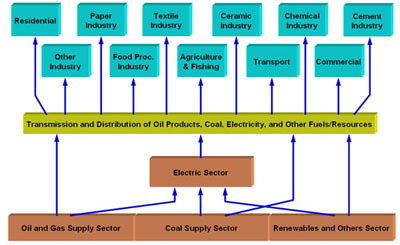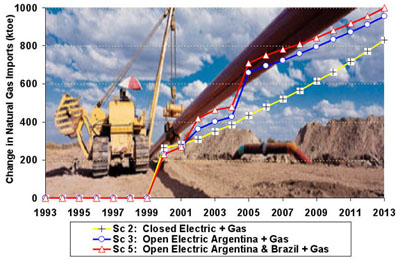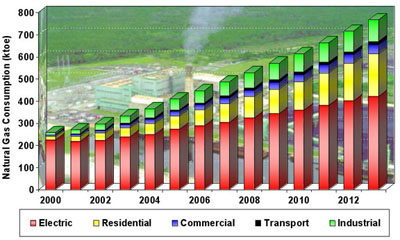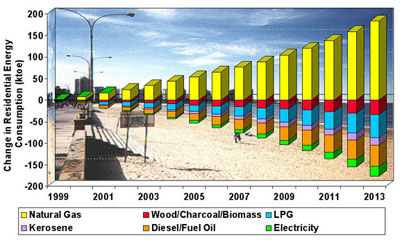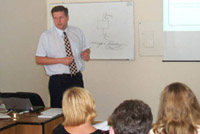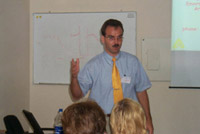| Center for Energy, Environmental, and Economic Systems Analysis (CEEESA) |  |
Research Areas:
Energy, Environment, and
Economics
National and Homeland
Security
Infrastructure Assurance
Emergency Preparedness
Social Dynamics
Policy Analysis
Core Capabilities:
Systems Analysis
Modeling, Simulation, and
Visualization
Complex Adaptive Systems
Decision Support and Risk
Management
Information Sciences
Analyzing Uruguay's Natural Gas Market
Methodology: The Government of Uruguay contracted the Center for Energy, Environmental, and Economic Systems Analysis (CEEESA) to conduct a detailed energy supply and demand analysis using the Energy and Power Evaluation Program (ENPEP-BALANCE). Specifically, CEEESA was asked to analyze the potential for expanding electricity ties with Argentina and Brazil and developing a new natural gas infrastructure. CEEESA collaborated with several Uruguayan institutions, including the presidential planning office and oil, gas, and electric companies. Scope of Work: CEEESA developed energy demand projections based on a local analysis of past patterns, determined the market penetration of natural gas by sector, evaluated the effects of increased electricity exchanges, and estimated the potential level of natural gas imports from Argentina under different scenarios. CEEESA also installed ENPEP-BALANCE on local computers, provided training, and transferred all model runs to local PCs. Uruguay’s Energy Office and Ministry of Environment continue to use the model for energy and climate change studies, demonstrating the success of the project.
ENPEP-BALANCE Network for Uruguay Results of Analysis: CEEESA’s study revealed that natural gas imports will be strongly affected by the electric sector's projected capacity expansion plan. The level of electric system integration with Argentina and Brazil will also play a significant role in natural gas demand. With electric integration, electricity exports are expected to increase substantially, driving up the demand for natural gas in the power sector. Natural gas imports in 2013 are forecast to be 25-28% of primary energy. Results for the residential sector show that the overall market share of natural gas will reach around 24% by 2013, with a range of 0-83%, depending on gas availability by region. Although natural gas will displace some residential electricity demand in areas where it is available, overall electricity demand is not expected to change significantly. Similar results are available for other sectors. Projected Natural Gas Imports by Scenario Projected Natural Gas Consumption by Sector under Scenario 2 Projected Residential Fuel Substitution under Scenario 2 In a follow-on study financed by the U.N. Development Program, CEEESA staff assisted experts from Uruguay's Ministry of Environment, the National Energy Office (DNE), and the Planning Ministry (OPP) in extending the above analysis to include environmental concerns, particularly with regard to carbon and greenhouse gas (GHG) emissions. Please go to the download section at the bottom of this page to obtain an electronic version of Uruguay's GHG analysis report. Model Transfer, Training, and Capacity Building: As part of the project, CEEESA transferred the model to Uruguayan institutions involved in the analysis and provided training to a number of Uruguayan experts. CEEESA has extensive expertise and experience in capacity building through the assistance we provide to our ENPEP-BALANCE users around the world in the form of training and implementation support. For more than 25 years, we have conducted training courses in many locations around the world and have successfully trained over 1,300 experts from more than 90 countries in the use of our tools. ENPEP-BALANCE is actively in use in many of these countries. ENPEP-BALANCE training courses and workshops can be tailored to your specific needs and can last anywhere from a few days to a couple of weeks. Courses may be held at Argonne's facility in the Chicago area or at your facilities. Click here for information on past and upcoming training courses or click on the pictures below. Additional Resources: For more information on this application and the ENPEP-BALANCE model, download the following brochures, presentations, and papers in pdf format:
For more information, contact CEEESA |
| U.S. Department of Energy Office of Science | UChicago Argonne LLC |
| Privacy & Security Notice | Contact Us | Search |
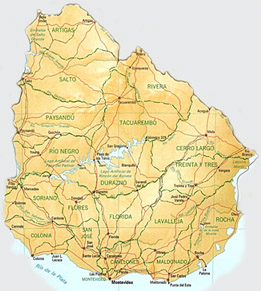
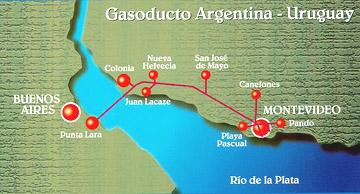 CEEESA staff projected future fossil and nonfossil energy flows for Uruguay using the ENPEP-BALANCE
model. ENPEP-BALANCE is a generalized equilibrium model that consists of a system of simultaneous nonlinear relationships that specify the transformation of energy quantities and energy prices through the various stages of energy production, processing, and use. The basic assumption in the equilibrium approach is that the energy sector consists of autonomous energy producers and consumers that carry out production and consumption activities while pursuing individual objectives.
ENPEP-BALANCE is not an optimization model; rather, it simulates and describes energy market choices that are made by producers and consumers. For this study,
ENPEP-BALANCE used an energy network (see figure below) designed to simulate the interactions among all energy supply and demand sectors. Local experts developed a forecast for useful energy demand, such as residential space heat, industrial steam demand, and passenger transportation demand. CEEESA staff obtained the projected expansion of the electricity generation system from Uruguay’s electricity company (UTE). Uruguay’s oil company, ANCAP, provided oil-sector-specific information. Because one of the outputs of
ENPEP-BALANCE was the demand for electricity, we performed several iterations between the UTE expansion model and
ENPEP-BALANCE.
CEEESA staff projected future fossil and nonfossil energy flows for Uruguay using the ENPEP-BALANCE
model. ENPEP-BALANCE is a generalized equilibrium model that consists of a system of simultaneous nonlinear relationships that specify the transformation of energy quantities and energy prices through the various stages of energy production, processing, and use. The basic assumption in the equilibrium approach is that the energy sector consists of autonomous energy producers and consumers that carry out production and consumption activities while pursuing individual objectives.
ENPEP-BALANCE is not an optimization model; rather, it simulates and describes energy market choices that are made by producers and consumers. For this study,
ENPEP-BALANCE used an energy network (see figure below) designed to simulate the interactions among all energy supply and demand sectors. Local experts developed a forecast for useful energy demand, such as residential space heat, industrial steam demand, and passenger transportation demand. CEEESA staff obtained the projected expansion of the electricity generation system from Uruguay’s electricity company (UTE). Uruguay’s oil company, ANCAP, provided oil-sector-specific information. Because one of the outputs of
ENPEP-BALANCE was the demand for electricity, we performed several iterations between the UTE expansion model and
ENPEP-BALANCE.